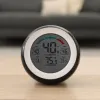Do you have an attached garage? I do. It’s convenient for storing tools, bicycles, and holiday decorations. Oh, and my car. That, too.
Unfortunately, attached garages are also a source of indoor air quality problems. Cars live in them, which means internal combustion engines live in them. Every time you start your car, it exhausts carbon monoxide, or CO, into the air.
In some cases, the CO can seep into your home.
Shutting the garage door is important, but it’s not the only solution.
By now you’re probably thinking, “Ok. I already open the garage door before cranking up my car. What else is there to know?”
Well, that is the main thing to remember if you don’t want car exhaust to make you sick. Always open the garage door before you put the key in the ignition. Pretty simple.
The thing is, car exhaust can linger in your garage for a while – even after you’ve backed into the driveway or after you’ve parked the car in the garage and shut off the engine. According to a fact sheet from the Iowa State University Department of Agricultural and Biosystems Engineering extension service, closing the garage door immediately after backing out of the car might create an unintended threat to health and safety:
“The effect of backing the car out of the garage should be monitored with a CO detector in the house (several detectors have digital displays and memories that can help determine if the CO in the house is elevated by backing the vehicle out of the garage). If carbon monoxide enters the house, it will be necessary to leave the garage door open after backing out until the CO clears.”
Every home is different. Every garage is different. Every garage ventilates differently. If you happen to have a garage that doesn’t ventilate particularly well – or one where the air inside the garage tends to migrate into your living space – you might need to change your garage habits.
Here’s how to prevent car exhaust from polluting your home.
The following primer isn’t a set of instructions. Rather, it’s a guide for determining whether CO from your car’s exhaust enters your home – and taking the appropriate steps to stop it.
- Don’t ever close the garage door while your car is running. By the same token, don’t ever crank your car before the door opens. Doing so presents real danger. CO concentrations in car exhaust are extremely high and can harm you very quickly.
- Keep the door open for a few minutes after parking your car. This gives the exhaust time to dissipate into the outdoor environment.
Install a CO detector in the room adjoining your garage. This might be a hallway, foyer, kitchen, or laundry room. Whatever room contains a door that opens to your garage, put a CO detector in there. And make sure you get a quality unit with sufficient CO sensitivity. - Monitor indoor CO concentrations after cranking or parking your car. Does the alarm go off following normal activity? If it does, then you need to heed steps 4 and 5.
- Air seal the area between your garage and your living space. When we say, “air seal,” we’re talking about applying fire-rated foam around wiring and plumbing penetrations between the garage and the living space. You should also have a quality weather seal around the door to the garage so that fumes can’t leak in.
- Install an exhaust fan in the garage. Here’s a great way to remove CO from your garage. Install a small exhaust fan that turns on every time you close your garage door. Connect it to a timer, and it will turn itself off after several minutes. You can also use a switch to turn it on and off manually. A properly sized fan will remove lingering car exhaust from your garage so that it doesn’t enter your living space.
Even if your carbon monoxide detector doesn’t go off while you’re testing things out (see #3 above), air sealing and/or installing an exhaust fan is smart. After all, “normal” conditions aren’t consistent. You might be in the habit of opening and closing the garage door at the appropriate times, but that doesn’t mean you’ll always remember to do so.
Forgetting to open the garage door before cranking your car is an innocent mistake, but the consequences can be serious. Good air sealing and an automatic exhaust fan can pick up the slack for our absentmindedness.
The exhaust fan is also a good idea when:
- You’ve got a really “tight,” energy-efficient house. Indoor air quality is the Achilles heel of many supposedly high-performance homes. They’re so well-sealed, the indoor air takes forever to escape! But while these homes are well-sealed in their entirety, the air sealing between the garage and the living space isn’t always so robust.
- You don’t like keeping the door open after you park. Maybe you are afraid people will steal your stuff or you’re worried about letting in cold air, hot air, humidity, or rain. Whatever your reasons for keeping that door shut tight, an exhaust fan is a way to mitigate the heightened CO risk.
We’ve all got our habits.
And they can be tough to break. However, when it comes to protecting yourself and your family from CO poisoning, changing your habits is worth the effort.
If you’re like most people, you won’t have to change anything about your garage habits – and that’s good! The only way to be sure is to get a CO detector, adopt good habits, and take action to reduce your risk.
The garages are great. Just be aware of the hazards they may pose.






